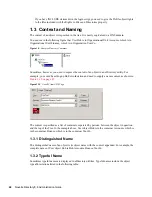
54
Novell eDirectory 8.8 Administration Guide
no
vd
ocx
(e
n)
6 Ap
ril 20
07
1.6 Replicas
A replica is a copy or an instance of a user-defined partition that is distributed to an eDirectory
server. If you have more than one eDirectory server on your network, you can keep multiple replicas
(copies) of the directory. That way, if one server or a network link to it fails, users can still log in and
use the remaining network resources (see
Figure 1-19 on page 54
).
Figure 1-19
eDirectory Replicas
Each server can store more than 65,000 eDirectory replicas; however, only one replica of the same
user-defined partition can exist on the same server. For a complete discussion of replicas, see
Chapter 5, “Managing Partitions and Replicas,” on page 129
.
We recommend that you keep three replicas for fault tolerance of eDirectory (assuming you have
three eDirectory servers to store them on). A single server can hold replicas of multiple partitions.
A replica server is a dedicated server that stores only eDirectory replicas. This type of server is
sometimes referred to as a DSMASTER server. This configuration is popular with some companies
that use many single-server remote offices. The replica server provides a place for you to store
additional replicas for the partition of a remote office location. (It can also be a part of your disaster
recovery planning, as described in
“Using DSMASTER Servers as Part of Disaster Recovery
Planning” on page 422
.)
eDirectory replication does not provide fault tolerance for the server file system. Only information
about eDirectory objects is replicated. You can get fault tolerance for file systems by using the
Transaction Tracking System
TM
(TTS
TM
), disk mirroring/duplexing, RAID, or Novell Replication
Services (NRS).
A master or read/write replica is required on NetWare servers that provide bindery services.
If users regularly access eDirectory information across a WAN link, you can decrease access time
and WAN traffic by placing a replica containing the needed information on a server that users can
access locally.
The same is true to a lesser extent on a LAN. Distributing replicas among servers on the network
means information is usually retrieved from the nearest available server.
User Workstations
User Workstations
Server A
Server B
Servers A and B
both hold replicas
of eDirectory.
When the link goes down,
users still have access to
eDirectory on their
local servers.
When the link is repaired, eDirectory
automatically synchronizes
the two replicas.
Summary of Contents for EDIRECTORY 8.8 SP2
Page 4: ...novdocx en 6 April 2007...
Page 116: ...116 Novell eDirectory 8 8 Administration Guide novdocx en 6 April 2007...
Page 128: ...128 Novell eDirectory 8 8 Administration Guide novdocx en 6 April 2007...
Page 255: ...256 Novell eDirectory 8 8 Administration Guide novdocx en 6 April 2007...
Page 406: ...408 Novell eDirectory 8 8 Administration Guide novdocx en 6 April 2007...
Page 563: ...566 Novell eDirectory 8 8 Administration Guide novdocx en 6 April 2007...
Page 573: ...576 Novell eDirectory 8 8 Administration Guide novdocx en 6 April 2007...
Page 601: ...604 Novell eDirectory 8 8 Administration Guide novdocx en 6 April 2007...
















































